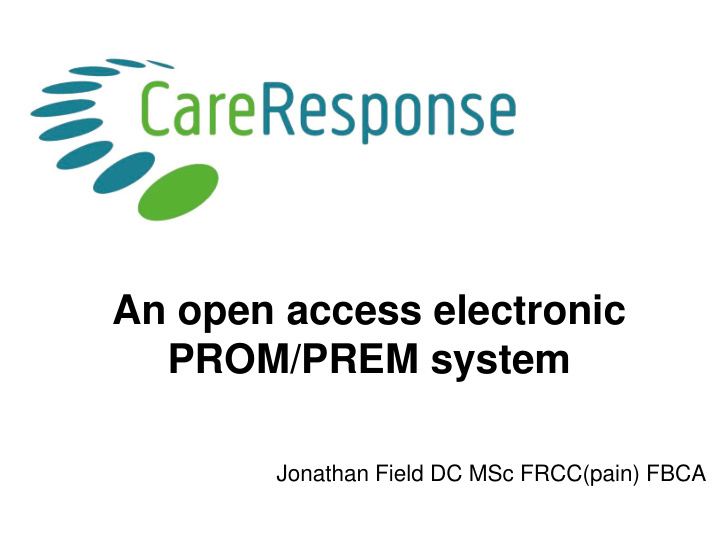



An open access electronic PROM/PREM system Jonathan Field DC MSc FRCC(pain) FBCA
Background • Regular PROM/PREM collection felt to be important Devlin, N., Appleby, J. & Buxton, M., 2010. Getting the • for practices most out of PROMs: putting health outcomes at the heart of NHS decision-making, London: The King's Fund. • for patients Snyder, CF. & Aaronson, NK., 2009. Use of patient- reported outcomes in clinical practice. The Lancet, • for the profession 374(9687), pp.369_370. Institute for Alternative Futures, 2013 Chiropractic • Difficulties to implement 2025: Divergent Futures, Available from http://www.altfutures.org/pubs/chiropracticfutures/IAF- Chiropractic2025.pdf. accessed 4th May 2016 • Difficult to make use of data Fung, CH. & Hays, RD., 2008. Prospects and challenges in using patient-reported outcomes in clinical practice. Quality of Life Research, 17(10), pp.1297_1302
Setting up a patient • Name • Date of birth • Date of appointment • Clinician • Assessments sent automatically at timed intervals
Results • Individual patients - either online or via email summary Single patient • Collated PROM/PREMs - live graphical reports online • Download available in excel format All patients in clinic
Clinical use • 414 chiropractors • 201 clinics • 12 countries • 778500 patients • @ 2000 new patients per month
Impact of Care Response data. Service purchasers • Influenced commissioning intent • Chiropractic service now providing over half of all non-tertiary care for spinal patients in North Hampshire CCG (population = 250,000)
Educational use • 5 undergraduate chiropractic AECC clinics Welsh Institute of Chiropractic
Research awards Newell, D.J. & Field, J.R., 2008. Who will get better? Predicting clinical outcomes in a chiropractic Jonathan Williams 2010 ‘ Is pain the cause of Peter Kent. Does patient level data improve Research practice . Clinical Chiropractic, pp.1 – 9. (ECU research predictive modelling of outcomes altered biomechancial functions in back pain prize) sufferers?’ PHd Thesis. Roehampton University University of Southern Denmark; Department of Field, J.R. & Newel. D.J. 2013 Does the STarT Back • 15 peer reviewed publications Sports Science and Clinical Biomechanics Tool shortly after the initial visit compared to before (3 papers under review) better predict outcomes in LBP patients . British Pain Society Academic Conference, Bournemouth (BPS P Irgens 1,2, L Lothe 1,2 , O Kvammen 1,2 ,J Field 3 ,D Conference Research Prize) Kieran Bernard 2015. The STarT Back • Putting researchers in touch Newell, The psychometric profile of Programme: The Perspectives of ‘Low Risk’ Newell, D.J. & Field, J.R., 2014 The management of with appropriate patients (3 chiropractic patients in Norway and Participants. STarT back high risk groups by chiropractic care: A England: using and comparing the generic PHd’s and 2 MSc’s) MSc dissertation . University of Brighton; School comparative description of outcomes stratified by versions of the STarT Back 5-item screening of Health Sciences risk ECU, Dublin (ECU Research Prize) tool and the Bournemouth Questionnaire. Field, J.R. & Newell, D.J., 2016. Clinical Outcomes in a 1 Private practice Norway, 2 Network of • Research collaboration Large Cohort of Musculoskeletal Patients Undergoing chiropractic research clinics in Norway, KiP, 3 Chiropractic Care in the United Kingdom: A Private practice, UK, 5 Anglo-European College Comparison of Self- and National Health Service- of Chiropractic, UK Referred Routes . Journal of Manipulative and Physiological Therapeutics , 39(1), pp.54 – 62. (WFC research Award)
Information Governance • Data ‘belongs’ to the clinic registering patients • Comprehensive IG policies and protocols • All data encrypted before transmission and storage • Audit trail of any access to data • Unique user access maintained by password login • Hosted in secure data center
Provides: • Collection of PROM/PREM with minimum work by practice • Tracking individual patients progress and experiences with care • Describing outcomes for chiropractors or practices • ‘Big data’ for research and national level reporting Supported and promoted by
• The wide scale adoption of this system by clinics, academic institutions and the support / collaboration with national organisations demonstrates the perceived value and practicality of ePROM/PREM systems. • The publications and academic partnerships illustrates the power of routinely collecting large data sets in research and in promoting cross professional partnership. • Further work is called for to understand barriers to using ePROMs systems and also into the proportion of clinics who enrol subsequently stop drop out. Supported and promoted by
• Developed by chiropractic clinicians and academics. • Very simple to use - register patients once and all other activity is automated including their consenting. • Currently provided at no cost for clinical use. • No adverts etc • Registration via online wizard.
ePROM systems • Paper and electronic versions of PROM/PREM surveys can be used interchangeably • Computer-based technology Muehlhausen, W. et al., 2015. Equivalence of can significantly improve electronic and paper administration of patient- completeness and quality of reported outcome measures: a systematic review and meta-analysis of studies conducted between the data returned. 2007 and 2013. Health and quality of life outcomes, 13(1), pp.1_20. • Savings in administration, Shervin, N. et al., 2011. Comparison of Paper and clinicians time and resources Computer-Based Questionnaire Modes for Measuring Health Outcomes in Patients Undergoing Total Hip Arthroplasty. The Journal of Bone and Joint Surgery, 93(3), pp.285_293.
Recommend
More recommend